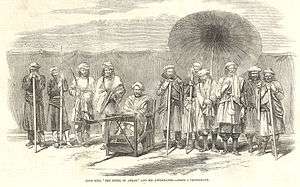Jagdishpur estate
The Jagdishpur estate was a zamindari estate situated in modern-day Bihar, India in erstwhile Shahabad district (now in Arrah).[1] The centre of the estate was the town of Jagdispur however the estate also covered neighbouring towns and villages.[2] The estate was also protected by a fort.[2]

Jagdishpur Raj | |
|---|---|
| 1702–1858 | |
| Capital | Jagdispur |
| Religion | Hinduism |
| Historical era | Middle Ages |
• Established | 1702 |
• Disestablished | 1858 |
History
The Jagdishpur estate was ruled by a branch of the Ujjainiya Rajputs.[3] These Ujjainiyas claimed descent from the Paramara dynasty of Malwa and the Bhojpur region of Bihar was named after the Paramara King, Raja Bhoj.[3] Sujan Sahi who was the son of Prabal Sahi Singh, was the first to take up residence in Jagdishpur in 1702.[4] After being killed by the retainers of the Governors of Bihar, he was succeeded by his son Udwant Singh who was said to be well-trained in the use of weapons and an able administrator. Udwant Singh expanded his territories by invading neighbouring towns and villages controlled by neighbouring landowners. Upon hearing this, the governor of Bihar, Fakkhradaula invaded Jagdishpur but Udwant Singh defeated him. Udwant Singh also encouraged the Ujjainiyas to eat pork to prevent them converting to Islam.[4] In his court, he patronised the poet, Mauli Kavi, who compiled the book Udwant Prakash in 1747.[5] After much conflict and many years of struggle, Jagdishpur was finally be subdued by the Mughals after the death of Udwant Singh.[6]
Under the leadership of Dalpat Shahi in the 18th century, Jagdishpur became the principal military stronghold of the Ujjainiya clan.[7] Mughal sources from the time note that the cavalry was the elite section of the Jagdishpur army and was considered to be superior to the infantry.[7]
1857 rebellion
During the rule of Kunwar Singh, the estate took part in the Indian Rebellion of 1857.[8][2] Kunwar Singh was motivated to rebel after having financial difficulties due to the high revenue demanded by the British authorities and family litigation.[9] The British also attempted to take over the management of the estate.[10]
As a result of this, Kunwar Singh (who was 80 at the time) decided to join the rebellion and was considered to be the leader of the rebellion in Bihar.[9] He was helped by his brother, Babu Amar Singh and his commander-in-chief, Hare Krishna Singh. After some initial success, Kunwar Singh and his forces were eventually driven out of Jagdishpur by the British. A year later, Kunwar Singh died and the rebellion was led by his brother who was eventually captured and hanged.[9] Because of these events, many consider Kunwar Singh to be one of the "greatest chiefs" of Jagdishpur.[5]
Rulers
From 1702 to 1947, the Jagdishpur estate was ruled by the following individuals[11]
- Sujan Shahi
- Udwant Singh
- Gajraj Singh
- Dalpat Shahi
- Shivraj Singh
- Bhoop Naryan Singh
- Ishwari Prasad Singh
- Shahebzada Singh
- Kunwar Singh
- Babu Amar Singh
- Shriniwas Singh
- Digvijay Singh (acceded to Indian Union in 1947)
References
- Usha Jha (2003). Land, Labour, and Power: Agrarian Crisis and the State in Bihar (1937-52). Aakar Books. pp. 50–. ISBN 978-81-87879-07-7.
- Anand A. Yang (1 February 1999). Bazaar India: Markets, Society, and the Colonial State in Bihar. University of California Press. pp. 145–147. ISBN 978-0-520-91996-9.
- Sanjay Garg (30 August 2018). Studies in Indo-Muslim History by S.H. Hodivala Volume II: A Critical Commentary on Elliot and Dowson’s History of India as Told by Its Own Historians (Vols. V-VIII) & Yule and Burnell’s Hobson-Jobson. Taylor & Francis. pp. 423–424. ISBN 978-0-429-75777-8.
- Surendra Gopal (22 December 2017). Mapping Bihar: From Medieval to Modern Times. Taylor & Francis. pp. 204–206. ISBN 978-1-351-03416-6.
- Tahir Hussain Ansari (20 June 2019). Mughal Administration and the Zamindars of Bihar. Taylor & Francis. pp. 135–140. ISBN 978-1-00-065152-2.
- Sir John Wardle Houlton (1949). Bihar, the heart of India. Orient Longmans. p. 50.
- Surendra Gopal (22 December 2017). Mapping Bihar: From Medieval to Modern Times. Taylor & Francis. pp. 293–. ISBN 978-1-351-03416-6.
- Jeffrey Witsoe (5 November 2013). Democracy against Development: Lower-Caste Politics and Political Modernity in Postcolonial India. University of Chicago Press. pp. 172–. ISBN 978-0-226-06350-8.
- S. Purushottam Kumar (1983). "Kunwar Singh's Failure in 1857". Proceedings of the Indian History Congress. 44: 360–369. JSTOR 44139859.
- Mia Carter; Barbara Harlow (31 December 2003). Archives of Empire: Volume 2. The Scramble for Africa. Duke University Press. pp. 401–402. ISBN 0-8223-3164-0.
- Datta, K.K (1957). Biography of Kunwar and Amar Singh. K. P. Jayaswal Institute. pp. 7-12. Retrieved 25 April 2019.